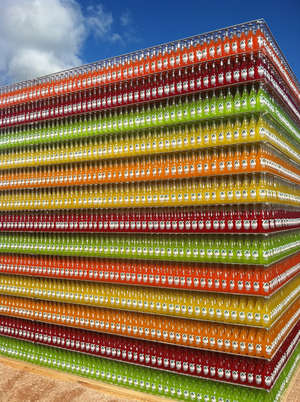While the crowds at Design Miami sipped oceans of champagne, there was talk of other bubbles, including the real estate mania that has condo developers learning Portuguese. The Design District, itself frothy with Prada and Louis Vuitton, was also home to the Inflatable Villa, an iconic (and possibly Ionic) installation by designer Luis Pons. The blow-up villa made its debut at the 2005 fair, as a symbol of exuberance. This time it appeared on a Design District construction site, seemingly impaled on rusty rebar, where it was deflated and reinflated daily—Pons' commentary on real estate booms and busts. "It's the same piece as in 2005, but the meaning has completely changed," he said.
 |
| Muñoz and Co.'s tower of thousands of bottles of Jarritos, a soft drink popular along La Frontera. |
Around the corner, San Antonio architecture firm Muñoz and Co. also used inflatables to comment on American consumerism, with balloony, cartoony facades of Latino-inflected retailers (think Tiffani). (The goal was to promote the firm's Mestizo Regionalism, a brand of modernism with a Tex-Mex flavor.) The firm’s tower made of thousands of bottles of Jarritos, a soft drink popular along La Frontera, became a backdrop for photos.
But the architect getting most of the attention may have been Le Corbusier. At Design Miami, Galerie Patrick Seguin was selling more than a dozen chairs, tables, and sofas from Corbu's government complex in Chandigarh. Though the gallery (its booth an elaborate simulation of a Corbusian building) claims it has rescued pieces neglected in India, some scholars are outraged that the furniture (by Le Corbusier's cousin and confidant Pierre Jeanneret) has been removed from the buildings it was designed for. "I'm revolted," said Jean-Louis Cohen, an architectural historian and curator of a show on Le Corbusier that will open in New York's Museum of Modern Art in June. Cohen was admiring a 1:1 model of the Cabanon, the seaside villa Corbusier constructed in Cap-Martin, France in 1952. The brand new model, made by Poltrona Frau (the Italian furniture company, in collaboration with the Le Corbusier Foundation), was the hit of Poltrona Frau’s Design District showroom. (It will be part of the MoMA exhibition next year.) "It's bigger than I thought," said Andrés Duany, the urban planner, after poking his head into the one-room building. Duany and Cohen had a quibble: The model of the Cabanon was more polished than the original. As Cohen observed, Poltrona Frau used cabinetmakers, while Corbu had employed carpenters; he wasn't trying to achieve perfection.
But most of the attention in Miami swirled around the art fairs, and if there wasn't a lot of new architecture in the city, there was a lot of architecture-themed painting, photography, and sculpture. Among those artists working edificially were Evol (at the Scope fair), who stencils details of mundane Berlin facades onto found metal panels, and Raphael Zarka (at NADA), who creates plywood models, as polished as anything by Poltrona Frau, of buildings "lifted" from Renaissance paintings. Architecture is in vogue in Miami this week, but often in items collectors can carry home.

Post a comment to this article
Report Abusive Comment